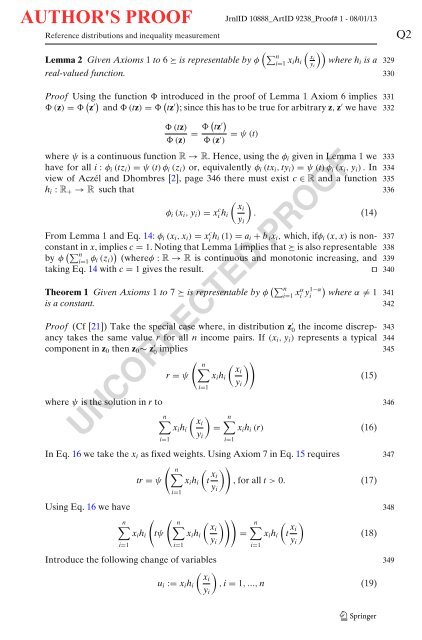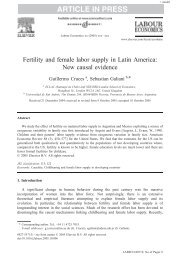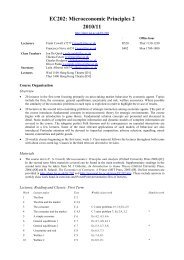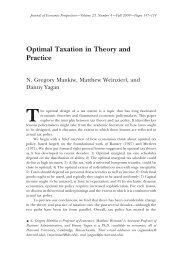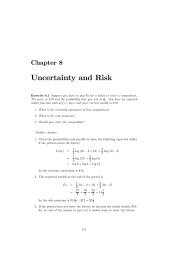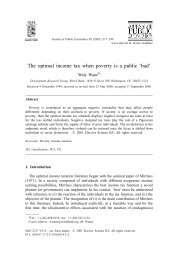author's proof - DARP
author's proof - DARP
author's proof - DARP
Create successful ePaper yourself
Turn your PDF publications into a flip-book with our unique Google optimized e-Paper software.
AUTHOR'S PROOF<br />
Reference distributions and inequality measurement<br />
JrnlID 10888_ArtID 9238_Proof# 1 - 08/01/13<br />
Q2<br />
Lemma 2 Given Axioms 1 to 6 ≽ is representable by φ<br />
( ∑n<br />
i=1 x ih i<br />
(<br />
xi<br />
y i<br />
))<br />
where h i is a 329<br />
real-valued function. 330<br />
Proof Using the function introduced in the <strong>proof</strong> of Lemma 1 Axiom 6 implies 331<br />
(z) = ( z ′) and (tz) = ( tz ′) ; since this has to be true for arbitrary z, z ′ we have 332<br />
(tz)<br />
(z) = ( tz ′)<br />
(z ′ ) = ψ (t)<br />
where ψ is a continuous function R → R. Hence,usingtheφ i given in Lemma 1 we 333<br />
have for all i : φ i (tz i ) = ψ (t) φ i (z i ) or, equivalently φ i (tx i , ty i ) = ψ (t) φ i (x i , y i ) . In 334<br />
view of Aczél and Dhombres [2], page 346 there must exist c ∈ R and a function 335<br />
h i : R + → R such that 336<br />
( )<br />
φ i (x i , y i ) = xi c h xi<br />
i . (14)<br />
y i<br />
From Lemma 1 and Eq. 14: φ i (x i , x i ) = xi ch i (1) = a i + b i x i , which, ifφ i (x, x) is non- 337<br />
constant in x, implies c = 1. Noting that Lemma 1 implies that ≽ is also representable 338<br />
by φ (∑ n<br />
i=1 φ i (z i ) ) (whereφ : R → R is continuous and monotonic increasing, and 339<br />
taking Eq. 14 with c = 1 gives the result. ⊓⊔ 340<br />
Theorem 1 Given Axioms 1 to 7 ≽ is representable by φ (∑ n<br />
)<br />
i=1 xα i y1−α i where α ̸= 1 341<br />
is a constant. 342<br />
Proof (Cf [21]) Take the special case where, in distribution z ′ 0<br />
the income discrep- 343<br />
ancy takes the same value r for all n income pairs. If (x i , y i ) represents a typical 344<br />
component in z 0 then z 0 ∼ z ′ 0<br />
implies 345<br />
( n∑ ( ) )<br />
xi<br />
r = ψ x i h i (15)<br />
y<br />
i=1 i<br />
where ψ is the solution in r to 346<br />
n∑<br />
( )<br />
xi<br />
n∑<br />
x i h i = x i h i (r) (16)<br />
y i<br />
UNCORRECTED PROOF<br />
i=1<br />
i=1<br />
In Eq. 16 we take the x i as fixed weights. Using Axiom 7 in Eq. 15 requires 347<br />
( n∑ (<br />
tr = ψ x i h i t x ) )<br />
i<br />
,forallt > 0. (17)<br />
y<br />
i=1<br />
i<br />
Using Eq. 16 we have 348<br />
(<br />
n∑<br />
n∑ ( )<br />
x i h i<br />
(tψ<br />
)) xi<br />
n∑<br />
(<br />
x i h i = x i h i t x )<br />
i<br />
(18)<br />
y<br />
i=1<br />
i=1 i y<br />
i=1<br />
i<br />
Introduce the following change of variables 349<br />
( )<br />
xi<br />
u i := x i h i , i = 1, ..., n (19)<br />
y i


